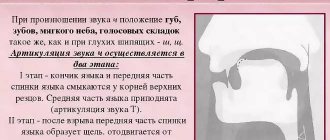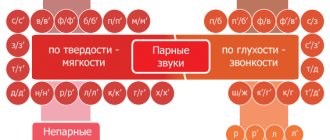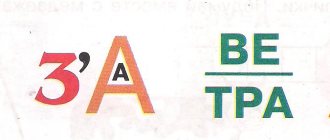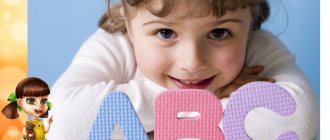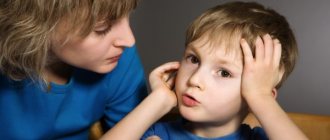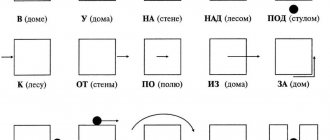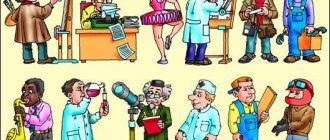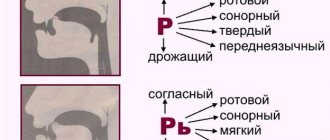Exercises for making hissing sounds in children
Sound pronunciation is formed in children from the first months of life. The baby pronounces vowels first, and this is an involuntary process. For up to three years, it can distort the sound of certain sounds. And by the age of five or six, before going to preparatory class, the baby should have a fully formed phonetic range.
Speech therapy sessions with a child
On the sound “sh”, speech therapy classes are usually often carried out in the older group of kindergarten. It includes:
- Identifying the problem using speech therapy materials and tables,
- Articulation gymnastics, staging and automation,
- Homework for the child so that the working moment goes more successfully and efficiently. It usually includes various exercises.
When the child has mastered the sound “sh”, you can move on to “zh”. Then the process of differentiating these sounds will be easier, since their articulation is the same. The baby will learn to distinguish where he hisses with calm vocal cords, and where he needs to add vibration.
Important ! As a rule, many children cannot cope with hissing words due to their replacement with “s”. It turns out to be a whistle instead of a hiss. It is worth paying attention to speech when pronouncing sounds. Many children can be helped by comparisons with the movement of a train or the flight of a bumblebee.
Any exercises in speech therapy to produce sounds begin with articulatory gymnastics. This helps prepare the device for proper operation and at the same time relax it.
Articulation gymnastics
In speech therapy classes starting with the letter “w,” articulatory gymnastics occupies a special place. It should be done 2-3 times daily for 5-10 minutes. It is best to stand near a mirror - this way the baby can immediately see his shortcomings and repeat correctly after the adult.
Articulation gymnastics during staging
Exercises:
- "Smile-pipe." Be sure to close your teeth and hold them in this position. Stretch your lips in a smile and fix them for 5 seconds, then stretch them forward into a tube - also for 5 seconds. Repeat 5-7 times.
- "It's hot - it's cold." Open your mouth as if it were hot, and then close it as if it were cold.
- "Pancake." Open your mouth, smile. Then put your tongue on your lower lip, remove it, and put it back again. Keep your mouth smiling.
- "Chatterer." Quickly move your tongue along your upper lip and play “bl-bl-bl.”
Consultation for parents on speech development of children 3-4 years old
Examination of the pronunciation of the sound “Ш”
When examining pronunciation, a specialist must find out how the sound being tested is pronounced separately, in words, in speech. For this purpose, images whose names include “Ш” can be used. It is important that it occupies different positions and combines with other sounds. The little student is asked to recite a poem in which the words have an "W".
If a child does not clearly pronounce an isolated “Sh”, you must first introduce this sound, and then consolidate its pronunciation in speech. If a child correctly pronounces a separate sound, but the defect is observed only in words, you need to work on consolidating it in speech.
Rules for testing at home:
- The child is in a calm state, repeating the necessary words after one of the parents. When forced into pronunciation, the sound is often distorted.
- The child pronounces the desired sound more than once. Sometimes children, even if they have a defect, can imitate the correct sound and the violation is not immediately noticed. It is easier to hear defective pronunciation in words where “Ш” is pronounced together with other consonants. To check, the child should pronounce the following words: chestnut, muffler, punch, mouthpiece.
For some children, the problem can be overcome in the first lessons; for others, the defect is dealt with step by step over some time, selecting appropriate tasks and techniques.
Lessons on making the sound “sh”
Staging the sound sh during speech therapy exercises can be done using different methods:
- From "s".
- From "t".
- From "r".
- And even from “a, uh, s”
Staging according to the method of Balova O.I.
Proper production of sounds
The most common way to correctly produce the “sh” sound is the “s” method. It is used when there are no defects or problems with the speech apparatus. It is also important that the whistling sound is not pronounced. The baby first begins to pronounce “s”, releases air, and then tenses his tummy a little more when exhaling. This produces hissing. You can also try pressing lightly on the baby's diaphragm (stomach) as you exhale to help the process. Facial expressions should not change, there can be no tension!
Note ! Difficulties in pronouncing sibilants can arise due to improper speech breathing, problems in speech hearing and the individual structure of the frenulum. Therefore, you should first identify the presence of these issues and visit specialists. If they are absent, proceed with sound production with a speech therapist.
From “t” in speech therapy, a diagnosis is made for interdental sigmatism of a child. First, the baby is taught to touch the upper teeth, and then very slowly pronounce the correct sound from “t”.
From “r” the setting is performed only if there is a confident “r”. “R” is pronounced quietly, almost in a whisper, the exhalation pressure decreases - it turns out “sh”.
For vowels, the production of “sh” can be done at home, since it does not require the presence of a speech therapist. The baby pronounces vowels and raises his tongue to the sky with a special tool.
Sound Automation
Automation of “sh” occurs when working with syllables, words and sentences. For a more enjoyable pastime, you can buy special coloring books, pictures, cards or a drawing album, where you can draw illustrations with your child. The baby will draw and speak at the same time, thereby strengthening the skills.
Tasks starting with "sh", coloring book
The following activities are held in the form of a game:
- First, individual syllables are pronounced: sho-sha-shu-she-shi,
- Then the words are added: checker, highway, cones,
- And then you can move on to sentences, tongue twisters: Sasha walked along the highway and sucked on a dryer.
Methods of speech therapy examination of children according to Akimenko V.M.
Articulation
The key to good pronunciation is the correct articulation of the sounds sh and zh. To teach a child to pronounce the letters sh and z correctly, it is necessary to study one method of articulation, since the speech apparatus works almost identically when pronouncing both letters. So, in order to correctly pronounce the letter w, it is necessary to work with the articulatory apparatus as follows:
- the baby's lips should be slightly pushed forward in the shape of a tube;
- the tip of the tongue is raised to the palate so that a small gap remains between them;
- the lateral edges of the child’s tongue are pressed against the upper outer teeth, giving the tongue the shape of a cup;
- a stream of air easily passes through the unused vocal cords, creating the necessary sound.
In order to understand how to teach a child to say the letter z, it is necessary to resort to the articulation described above, while connecting the vibrations of the vocal cords. Regular exercises for making sounds are very important. These exercises can be done with a speech therapist or at home.
Automation of the sound Ш in reverse syllables
Topic: Sound "Sh".
Stage: Automation in reverse syllables.
Goal: Learn to pronounce the sound “Ш” in reverse syllables.
Tasks:
- Continue to learn how to perform articulation exercises accurately and in full.
- Continue to form a strong, directed air stream.
- Learn to differentiate the sounds “Ш” and “С”.
- Learn to form comparative degrees of adjectives.
- Develop thinking and fine motor skills.
Equipment: a letter, a sound signal (“Ш”), a drawing of a swamp with hummocks, 5 books, images of a squirrel, a bear, a hare, a wolf, object pictures, a labyrinth-road to the hare’s house, a picture of who lives in which house.
Progress:
- Today we received a letter. And it says on it: “Open only after articulatory gymnastics. And exactly what exercises need to be done are depicted here: Fence, spatula, blanket, cup, focus, sail.”
Now we can open the letter.
- The hedgehog Misha wrote us a letter. He says that he loves books very much and he had a whole collection of them. But yesterday a strong storm arose and carried away all his books. And now they are scattered throughout the forest. Misha asks for help and is sure that only we can help him.
But to make it easier for us and not get lost, Misha sent his assistant. Recognize it: a cup-shaped tongue behind the upper teeth, teeth closed, lips smiling slightly (sound “Sh”). He will show us the way.
- Before us is a swamp with hummocks. To quickly pass it, you need to sing a song.
We walk over the bumps with our fingers: sha-sha-sha, sha-shy-sha, shy-she-shy, she-sho-she, sho-shu-sho.
We walked through the swamp and found the 1st book.
- We came to the squirrel's house. Squirrel also found a book. But he doesn’t want to give it away just like that. The storm mixed up all the items for her, but the squirrel loves order, so she asks to put the items into two baskets. In 1st - objects whose names contain the sound “S”. In the 2nd - with the sound “SH”.
I pronounce them, and you determine by ear where they need to be placed.
We helped the squirrel and she gave us the book she found.
- Let's move on... Here comes the bear. He also found a book. But he will give it away if we say that his berry is the best, he loves it very much.
I'll start, and you finish.
The berry is delicious, and his is even…tastier (red is redder, favorite is more loved, ripe is riper, beautiful is more beautiful, sour is sour).
Satisfied bear. I liked how we praised his berries and returned Mishka’s book to us.
- Let's move on to the sound "SH". Look, the bunny is sitting. He also found a book, but it was at his house, and the bunny was lost. Help him get to his house (goes through the labyrinth).
While we were helping the bunny, he was collecting carrots.
I picked the 1st carrot - ash, 2nd - ish, 3rd - ash, 4th - osh, 5th - ush.
So the bunny got home, and also with a carrot. He thanked him and gave him the book that the storm had brought him.
- Go ahead… . A wolf sits in front. He felt sad for some reason, and he was sad because he couldn’t decide where to place the animals. And he has the last book from the hedgehog's collection. The wolf says that if we help him, he will give us the book. Shall we help him? (Where will the hedgehog live)
- Here are all the books we have. Let's count them: 1 - ash, 2 - ish, 3 - esh, 4 - osh, 5 - ush.
- Our search for books has ended. And who helped us? (Sound “Sh”).
